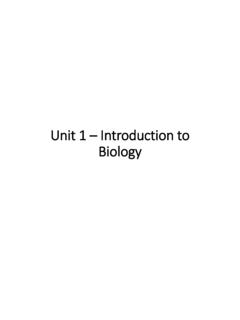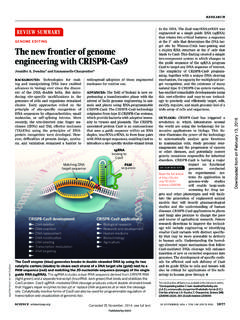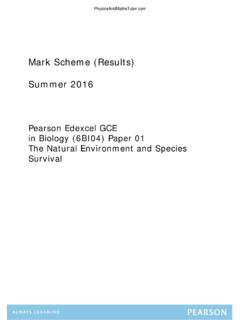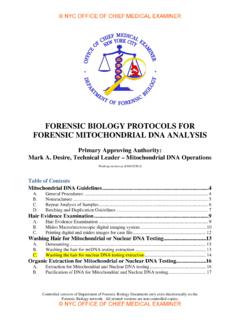Transcription of Oxford Cambridge and RSA AS Level Biology A - ocr.org.uk
1 INSTRUCTIONS Use black ink. You may use an HB pencil for graphs and diagrams. Complete the boxes above with your name, centre number and candidate number. Answer all the questions. Write your answer to each question in the space provided. If additional space is required, you should use the lined page(s) at the end of this booklet. The question number(s) must be clearly shown. Do not write in the The total mark for this paper is 70. The marks for each question are shown in brackets [ ]. This document consists of 24 over OCR 2016 [601/4261/3]DC (ST/SW) 123872/4 Last nameFirst nameCandidatenumberCentrenumberOxford Cambridge and RSAAS Level Biology AH020/01 Breadth in biologyThursday 26 May 2016 AfternoonTime allowed: 1 hour 30 minutesYou may use: a scientific calculator a ruler (cm/mm)*5976730042*OCR is an exempt Charity*H02001*2 OCR 2016 SECTION AYou should spend a maximum of 25 minutes on this all the your answer for each question in the box Microscopes vary in their magnification and resolution.
2 Which of the rows, A to D, in the table below is correct?Light microscopeTransmission electron microscopeScanning electron microscopeMagnificationResolution (nm)MagnificationResolution (nm)MagnificationResolution (nm)A 1500200 10 000 50 000 400100 500 100 000 1500200 500 000 100 000 1500100 500 100 Your answer [1]2 Carbohydrates, such as starch, are made from monosaccharides joined together. Which of the bonds, A to D, joins monosaccharides together? A ester B glycosidic C peptide D phosphodiester Your answer [1] 3 Turn over OCR 20163 Some inorganic ions have roles in enzyme-controlled reactions. Which of the rows, A to D, in the table below is correct?Role of ionCofactor for amylaseProsthetic group for carbonic anhydraseAZn2+Cl BZn+Cl CCl 2 Zn+DCl Zn2+ Your answer [1]4 Which of the following statements, A to D, about the nature of the genetic code is incorrect? A It is a degenerate code. B It is a triplet code.
3 C It is overlapping. D It is universal. Your answer [1]5 Ventilation involves various parts of the mammalian respiratory system. Which of the following statements, A to D, describes inhalation? A ribcage moves upwards and outwards; external intercostal muscles relax; diaphragm relaxes B ribcage moves downwards and inwards; external intercostal muscles relax; diaphragm relaxes C ribcage moves upwards and outwards; external intercostal muscles contract; diaphragm contracts D ribcage moves downwards and inwards; external intercostal muscles contract; diaphragm contracts Your answer [1]4 OCR 20166 Which of the following structures, A to D, are found in prokaryotes and in eukaryotes? A a cell wall made of peptidoglycan B circular genomic DNA C a nucleus surrounded by a nuclear membrane D ribosomes Your answer [1]7 The pressure changes in one mammalian cardiac cycle are shown in the graph below. (s)pressure(kPa)Keyventricular pressureatrial pressure Which of the following time periods, A to D, shows ventricular systole?
4 A to s B to s C to s D to s Your answer [1]5 Turn over OCR 20168 Measles is a serious disease that can be prevented by vaccination. The chart below shows the Measles-containing Vaccine (MCV) coverage and annual reported cases of measles between 1980 and 00019801 000 0001 500 0002 000 0002 500 000number of casesMCV coverage (%)3 000 0003 500 0004 000 0004 500 0005 000 0000102030405060708090100198119821983198 4198519861987198819891990199119921993199 4199519961997199819992000200120022003201 0201120122013200420052006200720082009num ber of casesMCV coverageyearKeyMeasles global annual reported cases andMCV coverage, 1980 2013 Which of the following statements, A to D, is a correct interpretation of the chart? A An increase in herd immunity resulted in fewer deaths from measles. B The highest number of measles cases occurred when MCV coverage was at its lowest. C A 90% MCV coverage resulted in fewer than half a million cases of measles each year.
5 D There is a positive correlation between the number of measles cases and the MCV coverage. Your answer [1] 6 OCR 20169 Two different fields, field G and H, were sampled for three common species of wildflower. The results are shown of individualsSpeciesField GField HDaisy 300 20 Dandelion 335 49 Buttercup 365 931 Total10001000 Which of the options, A to D, is correct? A Field G will have a greater Simpson s diversity index. B Field H has greater species evenness. C Field H will have a greater Simpson s diversity index. D Field G has greater species richness. Your answer [1]7 Turn over OCR 201610 Which of the following options, A to D, lists the three domains of life? A Archaea, Bacteria and Eukaryota B Bacteria, Prokaryota and Eukaryota C Prokaryotae, Protoctista and Eukaryota D Protoctista, Plantaea and Animalia Your answer [1]11 A student investigates some solutions, X, Y and Z, using paper chromatography. The results are shown front Which of the following options, A to D, is the Rf value of Z?
6 A B C D Your answer [1] 8 OCR 201612 Pressure varies in different parts of the mammalian circulatory in aortaTissue fluidLymphBlood in vena cavaPressure Which of the following options, A to D, correctly completes the table above? A high high low low B high low high low C high low low low D high low low high Your answer [1]13 A diagram of a potometer is shown clipair bubble Which of the following options, A to D, is a precaution that is not needed when setting up a potometer? A Remove excess water from the surface of the leaves before readings are taken. B The screw clip must be opened while taking the readings. C The shoot should be cut whilst under water. D There should be no extra air bubbles. Your answer [1]9 Turn over OCR 201614 The image shows a stage in mitosis. Which of the following options, A to D, is the stage of mitosis shown above? A anaphase B metaphase C prophase D telophase Your answer [1]15 The diagram below shows the simplified structure of an Which of the letters, A to D identifies the region of the antibody that allows the distance between the antibody binding sites to vary.
7 Your answer [1]10 OCR 201616 A group of students were investigating the diffusion of molecules across membranes using a model cell , as shown below. model cell cytoplasm (solutioncontaining starchand amylase) extracellular fluid Biochemical tests were used to identify the types of molecules present. The results are shown in the table below. A tick (3) represents a positive result. Which of the rows, A to D, shows the correct results for the cytoplasm at the beginning of the experiment and the extracellular fluid at the end of the experiment?Benedict s testBiuret testIodine test cytoplasm extracellular fluid cytoplasm extracellular fluid cytoplasm extracellular fluid A333B3333C3333D333 Your answer [1] 11 Turn over OCR 201617 Which of the cells below, represented by cubes A to D, has a surface area to volume ratio of 3 : 1 ?6 m4 m2 m1 mnucleusnucleusnucleusnucleusDCBA Your answer [1] 12 OCR 201618 A diagram of a stained blood smear observed under a light microscope is shown below.
8 BADC Which of the structures labelled A to D in the diagram is a neutrophil? Your answer [1] 19 Which of the following options, A to D, is a primary defence mechanism against pathogens? A neutralisation B agglutination C phagocytosis D blood clotting Your answer [1]13 Turn over OCR 201620 Pathogens cause disease and are transmitted from individual to individual in a variety of ways. Which of the rows, A to D, in the table below is correct?DiseaseType of pathogenMeans of transmissionAAthlete s footFungusDirect and indirect contactBHIV/AIDsVirusIndirect contactCMalariaBacteriumVectorDTuberculo sisProtoctistDirect contact Your answer [1] 14 OCR 2016 SECTION BAnswer all the Fig. shows some of the apparatus used in an experiment investigating water potential in potato tuber tubesucrose solutiondiscs of potato tuber tissueFig. The discs were placed in boiling tubes containing sucrose solutions of different concentrations for four hours.
9 The percentage change of mass was then calculated. The results are shown in Table of sucrose solution (mol dm 3)Change in mass of potato discs (%) + + + (a) (i) State two details of the procedure that must be followed to obtain valid results. 1 ..2 ..[2]15 Turn over OCR 2016 (ii) Explain how a student could use the data in Table to determine the water potential of the potato tuber tissue..[3] (b) Fig. shows a diagram of a cell from a potato tuber disc that was placed in mol dm 3 sucrose (i) Identify the parts of the cell labelled X, Y and Z. X .. Y .. Z .. [3] (ii) What will be found at W in the immersed cell? ..[1]16 OCR 2016 (c) Halophytes are plants that have the ability to live in soils with a very low water potential. In the UK these plants form part of salt marsh communities. Suggest and explain how the root hairs of halophytes are able to absorb water by osmosis from the soil of the salt marsh.
10 [2]17 Turn over OCR 201622 Even the smallest DNA molecules are very long. A kilobase (Kb) is a unit equivalent to 1000 base pairs of a DNA molecule. One Kb of double stranded DNA has a length of m. (a) The DNA in the nucleus of a cell from a fruit fly (Drosophila) is cm long. (i) Calculate the number of Kb in the DNA of the fruit fly. Show your working. Give your answer to the nearest whole number. Answer = .. Kb [2] (ii) The DNA of the fruit fly was analysed and 22% of the bases were adenine. What % of the bases were guanine? Show your working. Answer = .. % [2] (b) A DNA molecule contains polynucleotide strands. (i) Individual nucleotides are joined together to make a polynucleotide strand. What type of chemical reaction takes place when two nucleotides in a single polynucleotide strand are joined together? ..[1] (ii) Name the chemical released when the bond is formed between the two nucleotides..[1] (iii) A DNA molecule contains two polynucleotide chains.

















